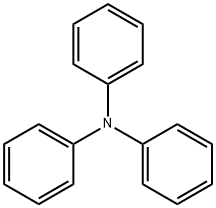Triphenylamine
- CAS NO.:603-34-9
- Empirical Formula: C18H15N
- Molecular Weight: 245.32
- MDL number: MFCD00003020
- EINECS: 210-035-5
- SAFETY DATA SHEET (SDS)
- Update Date: 2024-12-18 14:15:32

What is Triphenylamine?
Chemical properties
Monoclinic crystals from EtOAc.
Chemical properties
Triphenylamine is a colorless crystalline solid.
The Uses of Triphenylamine
Organic light-emitting diode (OLED) devices have received much attention, because they are expected to be a next generation display and light source, thanks to lightweight and flexible organic materials.
- Triphenylamine is a propeller-like structural chromophore with a nitrogen atom center. The compound has a large steric hindrance and hyper conjugation electronic effect, which can enhance the stability of the nitrogen atomic radical. Triphenylamine materials also have a high hole mobility due to their unique free radicals nature. Many hole transport materials based on triphenylamine derivatives (TPD) are widely usable,because they are heat-resistant and amorphous.In addition to the TPDs, oxadiazole derivatives (PBD) having an electron transport property, Alq3 as a host material,and blue emissive distylyl derivatives are fundamental materials for amorphous OLED devices.
- It is used in the manufacture of photographic film.
- Triphenylamines (TPAs) are highly fluorescent compounds that are efficient to induce cell death upon visible light excitation.
- Triphenylamine is used in organic light-emitting diode as hole-transporters and as a pharmaceutical intermediate.
- It is coated on film bases as primary photoconductor.
The Uses of Triphenylamine
It is coated on photographic film, where it acts as photoconductor.
The Uses of Triphenylamine
Triphenylamine is used in organic light-emitting diode as hole-transporters and as a pharmaceutical intermediate. It is coated on film bases as primary photoconductor.
Synthesis Reference(s)
Canadian Journal of Chemistry, 61, p. 86, 1983 DOI: 10.1139/v83-015
Organic Syntheses, Coll. Vol. 1, p. 544, 1941
Air & Water Reactions
Insoluble in water.
Reactivity Profile
Triphenylamine neutralizes acids in exothermic reactions to form salts plus water. May be incompatible with isocyanates, halogenated organics, peroxides, phenols (acidic), epoxides, anhydrides, and acid halides. Flammable gaseous hydrogen may be generated in combination with strong reducing agents, such as hydrides.
Health Hazard
Triphenyl amine is considered to have low systemic toxicity, but it may act as a slight skin irritant. Adverse effects have not been reported in humans.
Fire Hazard
The flash point of Triphenylamine has not been determined, but Triphenylamine is probably combustible.
Safety Profile
Moderately toxic by ingestion. When heated to decomposition it emits toxic fumes of NOx. See also AROMATIC AMINES.
Potential Exposure
Triphenylamine is used as a primary photoconductor and in making photographic film coated on photographic film bases.
Carcinogenicity
Triphenyl amine was not mutagenic in bacterial assays with or without metabolic activation.
Purification Methods
Crystallise the amine from EtOH or from *benzene/absolute EtOH, diethyl ether and pet ether. It is sublimed under vacuum and carefully dried in a vacuum line. Store it in the dark under nitrogen. [Beilstein 12 IV 276.]
Incompatibilities
Incompatible with oxidizers (chlorates, nitrates, peroxides, permanganates, perchlorates, chlorine, bromine, fluorine, etc.); contact may cause fires or explosions. Keep away from alkaline materials, strong bases, strong acids, oxo acids, epoxides, aldehydes, ketones.
Properties of Triphenylamine
| Melting point: | 124-128 °C (lit.) |
| Boiling point: | 347-348 °C (lit.) |
| Density | 0.7740 |
| refractive index | 1.3530 (estimate) |
| Flash point: | 365°C |
| storage temp. | Sealed in dry,Room Temperature |
| solubility | Chloroform (Slightly) |
| pka | -3.04±0.30(Predicted) |
| form | Crystalline Powder |
| color | Off-white to slightly beige |
| Water Solubility | insoluble |
| BRN | 2050487 |
| Exposure limits | NIOSH: TWA 5 mg/m3 |
| Stability: | Stable. Combustible. Incompatible with strong oxidizing agents. |
| CAS DataBase Reference | 603-34-9(CAS DataBase Reference) |
| NIST Chemistry Reference | Benzenamine, N,N-diphenyl-(603-34-9) |
| EPA Substance Registry System | Triphenylamine (603-34-9) |
Safety information for Triphenylamine
| Signal word | Warning |
| Pictogram(s) |
 Exclamation Mark Irritant GHS07 |
| GHS Hazard Statements |
H315:Skin corrosion/irritation H319:Serious eye damage/eye irritation H335:Specific target organ toxicity, single exposure;Respiratory tract irritation |
| Precautionary Statement Codes |
P261:Avoid breathing dust/fume/gas/mist/vapours/spray. P304+P340:IF INHALED: Remove victim to fresh air and Keep at rest in a position comfortable for breathing. P305+P351+P338:IF IN EYES: Rinse cautiously with water for several minutes. Remove contact lenses, if present and easy to do. Continuerinsing. P405:Store locked up. |
Computed Descriptors for Triphenylamine
Triphenylamine manufacturer
New Products
Tert-butyl bis(2-chloroethyl)carbamate 4-Methylphenylacetic acid N-Boc-D-alaninol N-BOC-D/L-ALANINOL N-octanoyl benzotriazole 3-Morpholino-1-(4-nitrophenyl)-5,6-dihydropyridin- 2(1H)-one Furan-2,5-Dicarboxylic Acid DIETHYL AMINOMALONATE HYDROCHLORIDE 1,1’-CARBONYLDIIMIDAZOLE R-2-BENZYLOXY PROPIONIC ACID 1,1’-CARBONYLDI (1,2-4 TRIAZOLE) N-METHYL INDAZOLE-3-CARBOXYLIC ACID (2-Hydroxyphenyl)acetonitrile 4-Bromopyrazole 5-BROMO-2CYANO PYRIDINE 5,6-Dimethoxyindanone 5-broMo-2-chloro-N-cyclopentylpyriMidin-4-aMine 2-(Cyanocyclohexyl)acetic acid 4-methoxy-3,5-dinitropyridine 1-(4-(aminomethyl)benzyl)urea hydrochloride 2-aminopropyl benzoate hydrochloride diethyl 2-(2-((tertbutoxycarbonyl)amino) ethyl)malonate tert-butyl 4- (ureidomethyl)benzylcarbamate Ethyl-2-chloro((4-methoxyphenyl)hydrazono)acetateRelated products of tetrahydrofuran








You may like
-
 Triphenyl amine CAS 603-34-9View Details
Triphenyl amine CAS 603-34-9View Details
603-34-9 -
 Triphenylamine 99% (GC) CAS 603-34-9View Details
Triphenylamine 99% (GC) CAS 603-34-9View Details
603-34-9 -
 Triphenylamine CAS 603-34-9View Details
Triphenylamine CAS 603-34-9View Details
603-34-9 -
 Triphenylamine CAS 603-34-9View Details
Triphenylamine CAS 603-34-9View Details
603-34-9 -
 Triphenylamine CAS 603-34-9View Details
Triphenylamine CAS 603-34-9View Details
603-34-9 -
 Triphenyl amine 98%View Details
Triphenyl amine 98%View Details -
 118753-70-1 98+View Details
118753-70-1 98+View Details
118753-70-1 -
 733039-20-8 5-broMo-2-chloro-N-cyclopentylpyriMidin-4-aMine 98+View Details
733039-20-8 5-broMo-2-chloro-N-cyclopentylpyriMidin-4-aMine 98+View Details
733039-20-8